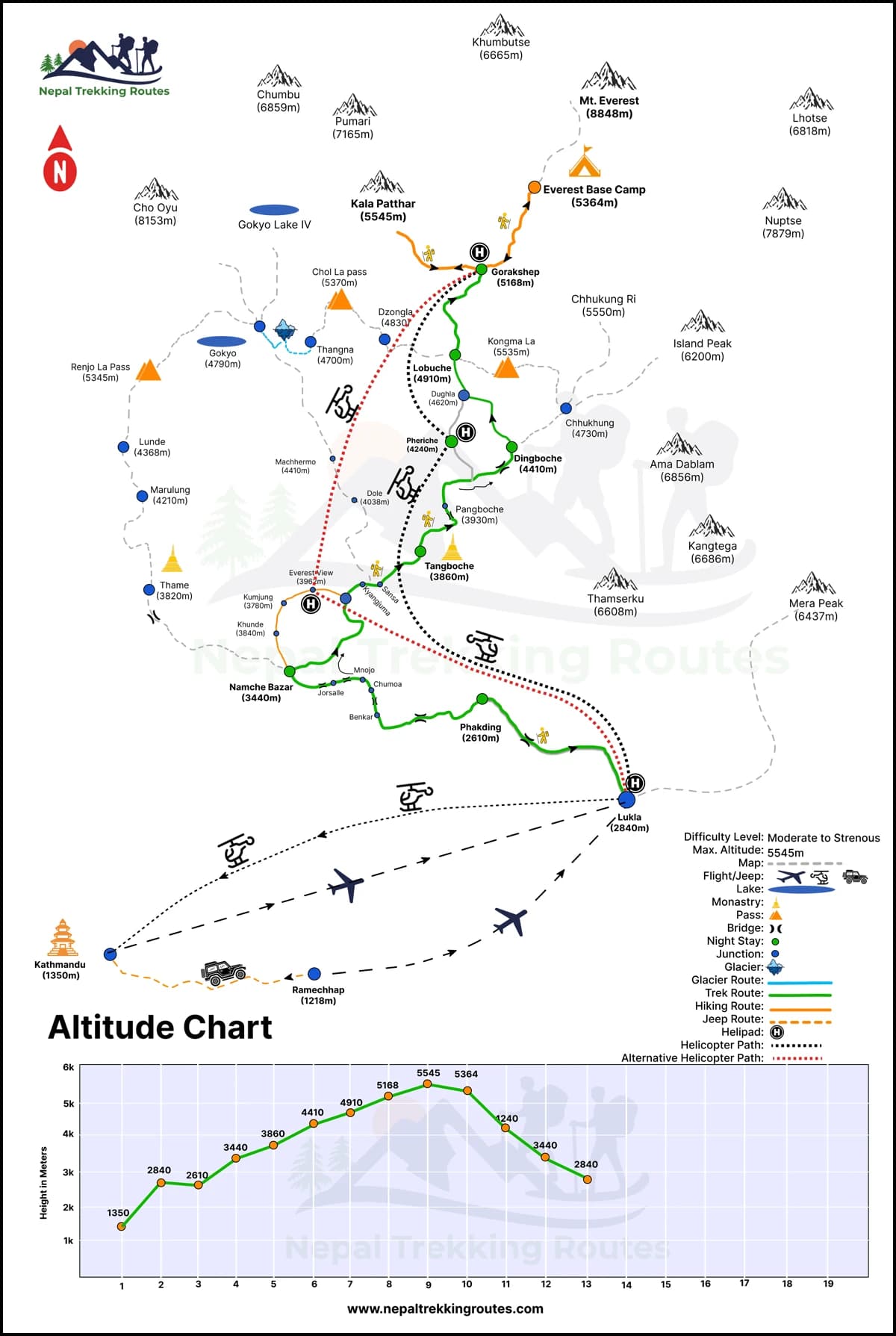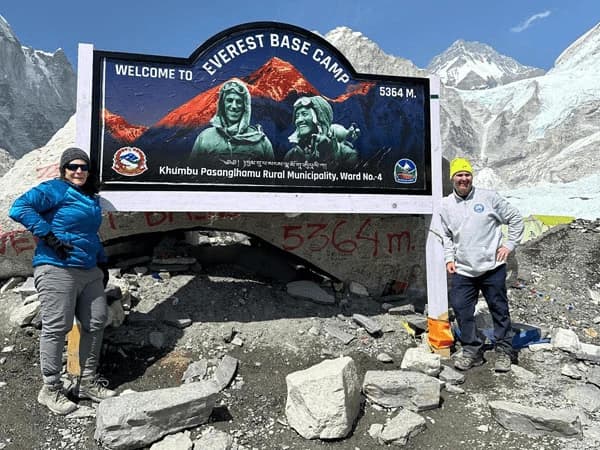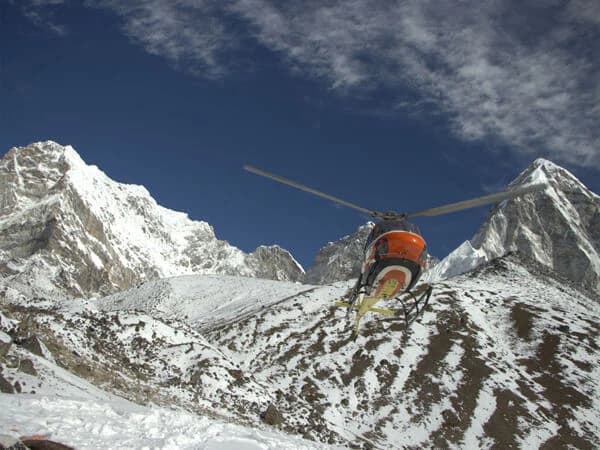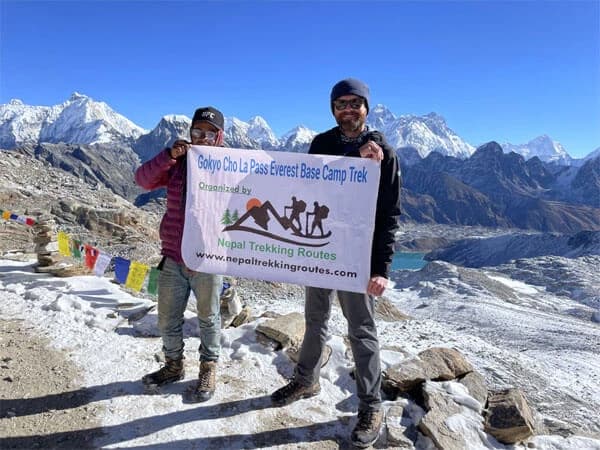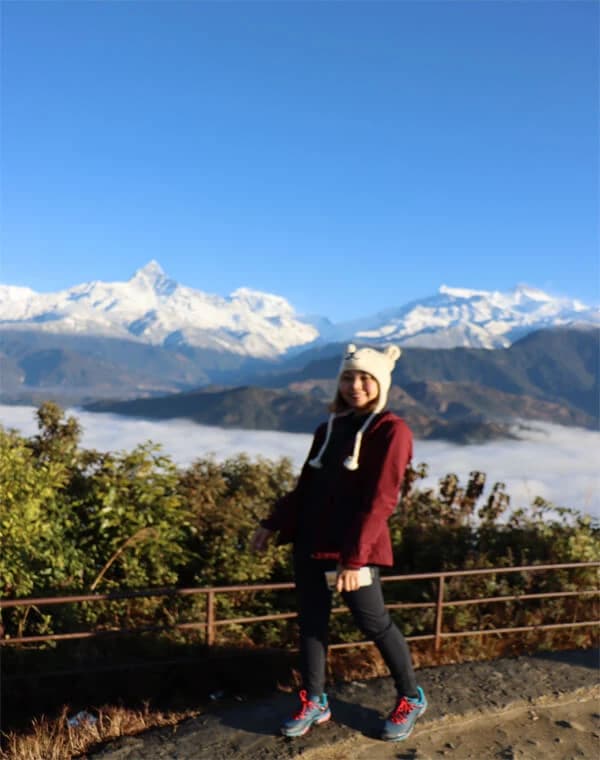Everest Base Camp Trek with Helicopter Return is a wonderful trip to the lap of the world's highest peak. This trip begins after a flight from Kathmandu to Lukla Airport, also known as the Tenzing Hillary Airport.
EBC Trek with Helicopter Return moves along the classic Everest Base Camp Trek Route. You will enjoy the Great Himalayas like Mt. Everest, Mt. Lhotse, Mt. Cho Oyu, Mt. Ama Dablam, Mt. Pumori, and many more.
Beginning from Lukla, the journey moves along the Sherpa Villages to Kalapatthar across Gorakshep. These villages reflect a true flavor of the Tibetan Buddhist culture, tradition, lifestyle, and shrines.
Biodiversity of Sagarmatha National Park, a UNESCO World Heritage Site makes your Everest Base Camp Helicopter Trek more memorable.
You cannot see the Everest Summit from Everest Base Camp(5,364m) because the soaring peaks hide it behind. However, you will have the closest views of the snowcapped peaks of the Everest Region from Kalapatthar.
You have a few options while trekking to EBC Helicopter Return Trek. You can fly back to the Kathmandu Airport after refueling at the Lukla Airport.
Or, you can begin the Everest Helicopter Return Tour from Periche, Dingboche, Tengboche, Namche Bazar, and other stopovers as well. The Everest Trek with helicopter experience is the best alternative to full Everest Base Camp Trek.
Everest Base Camp Trek with Helicopter Return Cost for 2025 and 2026
Everest Base Camp Trek withHelicopter Return price ranges from $2500 to $3100, including permits, accommodation, meals, guide and flight. Everest Base Camp Trek with Helicopter return price from Kathmandu can be reduced if you are trekking in a group.
Tara Airlines, Sita Air, Summit Airlines, and Goma Airlines are domestic carriers that operate regular flights to Lukla Airport from Tribhuvan International Airport (TIA). The cost for flights from Kathmandu to Lukla is approximately $180 for foreign nationals, $140 for Indian citizens, and NPR 8,000 for Nepalese citizens, one way.
Recently, the Civil Aviation Authority of Nepal has diverted direct flights to Lukla to Ramechhap Airport during peak season (spring and autumn). Trekkers must first reach Ramechhap Airport and can then take a direct flight to Lukla from there.
An Everest Base Camp Helicopter Trek budget package includes basic accommodations, meals, guide for the trekking journey and a return helicopter flight.
A Private Everest Base Camp Helicopter Trek includes personalized services, private transport and helicopter flight. EBC Helicopter Trek offers group discount due to shared expenses. We are one of the best trekking agency for Everest Base Camp trek with Helicopter return.
EBC Trek with Helicopter Return 11 Days Itinerary for 25/026
The 11 Days EBC Trek with Helicopter Return itinerary includes regular trekking to Everest Base Camp and taking a helicopter flight to return. We can tailor the itinerary for EBC Helicopter Return Trek to suit your requirement. The various options include number of trekking days, additional cultural visits, accommodation upgrade, helicopter ride to Kathmandu or Lukla and side trips.
To make your Everest Dream come true, you have a couple of choices. You can do Everest Base Camp Trek in about two weeks. Alternatively, you can do Everest Base Camp Helicopter Tour with landing and the EBC Heli Tour without landing as well. You can also combine Luxury Everest Base Camp Trek with Helicopter ride over Everest.
Everest Base Camp Trek with Helicopter Return Package offers you a mixed experience of Everest Base Camp Trek and Fly back by Helicopter over the Everest Region. You begin this trip by flying to Lukla from the Kathmandu Airport and then trekking up to EBC (5,364m).
After relishing the closest view of the Giant Mountains from Kalapatthar (5,555m), you can fly back to Kathmandu from there. Otherwise, you can do Everest Base Camp Trek with helicopter from Gorakshep to the Kathmandu Airport.
You can use a Helicopter ride shared in a group to return in about one hour to Kathmandu. Or else, you can also use a single chopper for Everest Base Camp Trek Helicopter Fly Out.
Why Everest Base Camp Trek with Helicopter Return is suitable for traveler?
Experienc the ultimate Himalayan adventure with Everest base camp trek and enjoy a thrilling Helicopter return,saving the time while soaking in aerial views of Nepal Himalayas. Enjoy the best of Everest trek and luxury in one unforgettable journey. Book your Everest adventure with Nepal Trekking Routes today.
Following the regular EBC Trek route, you move along the Sagarmatha National Park. The park is one of the ten UNESCO World Heritage Sites of Nepal. Many alpine birds and animals play hide and seek with you in the fir, birch, juniper, and rhododendron forest.
The Khumbu Region is the largest Sherpa settlement area of Nepal. You will have some good memories of the Sherpa culture and tradition in the stopovers. If you make the EBC Trek with chopper Return between October and November, you will observe the Mani Rimdu Festival.
To observe Dumje Festival, we recommend you to book this trek in Nepal, in the last week of May or the first week of June. Both festivals are celebrated in monasteries such as Tengboche Monastery, Panboche, Monastery, Khumjung Monastery, etc.
For those who have limited time in Nepal but want to fulfill their Everest Dream, we recommend short Everest Base Camp Trek with Helicopter Return. It is one of the best luxury trek in Nepal.
The Major Attractions of Everest Base Camp Trek with Helicopter Return
Everest Base Camp Helicopter support trek is full of natural and cultural wonders. The flight from Kathmandu to Lukla gives you an aerial view of Langtang, Ganesh Himal, Manaslu (8,163 m), Rolwaling Valley, and the Everest region as well. Walking along the rugged trails through Sagarmatha National Park, you see some animals and birds.
Namche Bazaar is one of the major attractions of this trip to the Himalayas. Namche Bazaar is the main trading hub of the entire Khumbu region. Although it is located in the Himalayan region, you can find all the modern amenities. Banks, cafés, restaurants, ATM booths, and good quality hotels are available.
You can visit Everest View Hotel nearby Namche which is called Everest View Trek as well. It is a five-star hotel located in this region. It is one of the highest-placed hotels in the world. While having breakfast and lunch here, you can have a picturesque view of Mt. Everest and other peaks. The trekkers in the Everest region must not miss this hotel for its wonderful view of the Himalayas. The Helicopter ride from Everest Base Camp is a scenic way for return journey.
Other beauties of Namche Bazaar are the Sherpa Museum and a local monastery. To collect all the information about the typical lifestyle, culture, and tradition of the Himalayan tribe, the Sherpa Museum is helpful. The Hall of Fame in the museum features a gallery of photographs from the historic 1953 Everest Expedition. You can see the photos of Tenzing and Hillary in this gallery.
Tengboche Monastery is the largest monastery in this region. If you plan your Nepal visit in between October and November, you can observe the Mani Rimdu Festival here. It is the most colorful festival of the Sherpas, the inhabitants of the Himalayas. It is celebrated for 19 days on the premises of Tengboche Monastery to mark the honor of Guru Rimpoche.
Similarly, you can visit the Pangboche Monastery located in Pangboche Village. It is the oldest monastery in this region. You can meet the monks and the Guru here. To know more about this shrine, you can talk to the friendly people of this village. The typical Sherpa cuisines served at the hotels in this region are also worth tasting.
Nepal Trekking Routes also offers Luxury Everest Base Camp Trek with Helicopter Return which includes premium services, high-end accommodations, gourmet dining and private transport. Our agency provides one of the best Everest Base Camp Trek with Helicopter return with exceptional service.
How to Book Everest Base Camp Trek with Helicopter Return?
For Everest Base Camp Helicopter Trek booking, directly click “Book Now” on the right side of this package. For payment as well, our site is user-friendly with an online payment system. We are one of the best Nepal trekking company for EBC Helicopter Trek. We also offer Everest Base Camp Helicopter Trek last-minute deals

.webp&w=3840&q=75&dpl=dpl_4U3CaZUV3Y5iKdBNPJmVMATJy3AB)
.webp&w=3840&q=75&dpl=dpl_4U3CaZUV3Y5iKdBNPJmVMATJy3AB)
.webp&w=3840&q=75&dpl=dpl_4U3CaZUV3Y5iKdBNPJmVMATJy3AB)
